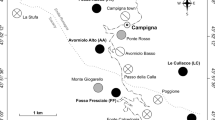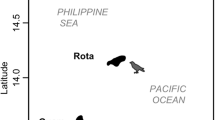Abstract
African driver ants are nomadic social mesopredators feeding on a highly diverse array of prey species at different trophic levels. Colonies of certain driver ant species have a biomass which can equal that of medium-sized mammalian carnivores and the ultimate cause of their nomadic life-style is thought to be local prey depletion. The impact of driver ant swarm raids is therefore expected to be strong but the degree to which they reduce prey populations has not been quantified and it is unknown whether these spectacular predators exert significant top-down effects. We examined the combined effect of driver ant (Dorylus molestus) and swarm-attending bird (Alethe poliocephala) predation on the population dynamics of earthworms, which constitute the ants’ main prey type in the montane forest of Mount Kenya. Pre-raid earthworm biomass densities in the soil layer down to a depth of 8 cm varied by a factor of 31. The immediate effect of swarm raids was a reduction in earthworm numbers in this layer, but 8 days later earthworm numbers had recovered to pre-raid levels. When earthworm biomass densities were compared, no significant effect of swarm raids was detected. The estimated proportion of earthworm prey biomass extracted from 0 to 8 cm layer by driver ants and birds together was about 2.2%. Although colony distribution was overdispersed as expected based on knowledge of D. molestus migratory behaviour, predation events were highly localized. Predation frequency was low (once every 62 days on average) and highly variable. These results indicate that earthworm prey is highly abundant but at the same time so difficult to harvest that swarm raids exert only a marginal influence on earthworm populations. Longer-term studies would be required to determine whether earthworm populations are limited by swarm raids. The small impacts of individual raids and rapid recovery of earthworm prey populations likely underlie the low frequency of migrations and short distances travelled by migrating colonies of D. molestus.



Similar content being viewed by others
References
Besag J. 1977. Contribution to the discussion of Dr. Ripley’s paper. J. R. Stat. Soc. B 39: 193-195
Brussaard L. 1998. Soil fauna, guilds, functional groups and ecosystem processes. Appl. Soil Ecol. 9: 123-135
Bussmann R. 1994. The Forests of Mt Kenya – Vegetation, Ecology, Destruction and Management of a Tropical Mountain Forest Ecosystem. PhD thesis, University of Bayreuth, Germany.
Chang C.-H., Rougerie R. and Chen J.-H. 2009. Identifying earthworms through DNA barcodes: pitfalls and promise. Pedobiologia 52: 171-180
Dejean A., Schatz B., Orivel J. and Beugnon G. 1999. Prey capture behavior of Psalidomyrmex procerus (Formicidae: Ponerinae), a specialist predator of earthworms (Annelida). Sociobiology 34: 545-554
Dunham A.E. 2008. Above and below ground impacts of terrestrial mammals and birds in a tropical forest. Oikos 117: 571-579
Fragoso C. and Lavelle P. 1992. Earthworm communities of tropical rain forests. Soil Biol. Biochem. 24: 1397-1408
Frank D.A. 2008. Evidence for top predator control of a grazing ecosystem. Oikos 117: 1718-1724
Franks N.R. 1980. The Evolutionary Ecology of the Army Ant Eciton burchelli on Barro Colorado Island, Panama. PhD thesis, University of Leeds, UK
Franks N.R. 1982. A new method for censusing animal populations: the number of Eciton burchelli army ant colonies on Barro Colorado Island, Panama. Oecologia 52: 266-268
Franks N.R. 2001. Evolution of mass transit systems in ants: a tale of two societies. In: Insect Movement: Mechanisms and Consequences (Woiwod I., Reynolds D.R. and Thomas C.D., Eds). CAB International Publishing, Wallingford, UK, pp 281-298
Franks N.R. and Fletcher C.R. 1983. Spatial patterns in army ant foraging and migration. Eciton burchelli on Barro Colorado, Panama. Behav. Ecol. Sociobiol. 12: 261-270
Franks N.R., Sendova-Franks A.B., Simmons J. and Mogie M. 1999. Convergent evolution, superefficient teams and tempo in Old and New World army ants. Proc. R. Soc. London B 266: 1697-1701
Freitas A.V.L. 1994. Nest relocation and prey specialization in the ant Leptogenys propefalcigera Roger (Formicidae: Ponerinae) in an urban area in southeastern Brazil. Insect. Soc. 42: 453-456
Gotwald W.H. Jr. 1974. Predatory behavior and food preferences of driver ants in selected African habitats. Ann. Entomol. Soc. Am. 67: 877–886
Gotwald W. H. Jr. 1978. Trophic ecology and adaptation in tropical Old World ants of the subfamily Dorylinae. Biotropica 10: 161-169.
Gotwald W.H. Jr 1995 Army Ants – The Biology of Social Predation. Cornell University Press. Ithaca and London. 302 pp
Hebert P.D.N., Cywinska A., Ball S.L. and deWaard J.R. 2003 Biological identification through DNA barcodes. Proc. R. Soc. London B 270: 313–321
Hendrix P.F. and Bohlen P.J. 2002. Exotic earthworm invasions in North America: ecological and policy implications. BioScience 52: 1-11
Hölldobler B. and Wilson E.O. 1990. The Ants. Cambridge, Massachusetts: Belknap Press of Harvard University Press. 732 pp
Hooper D.U., Bignell D.E., Brown V.K., Brussaard L., Dangerfield J.M., Wall D.H., Wardle D.A., Coleman D.C., Giller K.E., Lavelle P., van der Putten W.H., de Ruiter P.C., Rusek J., Silver W.E., Tiedje J.M. and Wolters V. 2000. Interactions between aboveground and belowground biodiversity in terrestrial ecosystems: patterns, mechanisms, and feedbacks. BioScience 50: 1049-1061
Keith S., Urban E.K. and Fry C.H. 1992. The Birds of Africa. Vol. 4. Academic Press. London. pp
Kingdon J. 1997. The Kingdon Field Guide to African Mammals. Academic Press. San Diego. 450 pp
Kronauer D.J.C., Schöning C. and Boomsma J.J. 2006. Male parentage in army ants. Mol. Ecol. 15: 1147-1151
Kronauer D.J.C., Schöning C., Vilhelmsen L. and Boomsma J.J. 2007. A molecular phylogeny of Dorylus army ants provides evidence for multiple evolutionary transitions in foraging niche. BMC Evol. Biol. 7: 56. http://www.biomedcentral.com/1471-2148/7/56
Lavelle P. 1997. Faunal activities and soil processes: adaptive strategies that determine ecosystem function. Adv. Ecol. Res. 27: 93-132
Lavelle P., Bignell D., Lepage M., Wolters V., Roger P., Ineson P., Heal O.W. and Dhillion S. 1997. Soil function in a changing world: the role of invertebrate ecosystem engineers. Eur. J. Soil Biol. 33: 159-193
Leroux J.M. 1982. Ecologie des populations de dorylines Anomma nigricans dans la Région de Lamto (Côte d’Ivoire). Publ. Lab. Zool. 22. E.N.S. Paris.
Moffett M.W. 1988. Nesting, emigrations, and colony foundation in two group-hunting Myrmicine ants (Hymenoptera: Formicidae: Pheidologeton). In: Advances in Myrmecology (Trager J.C., Ed). Leiden: E.J. Brill, pp 355-370
Perreault J.M., Whalen J.K. 2006. Earthworm burrowing in laboratory microcosms as influenced by soil temperature and moisture. Pedobiologia 50: 397-403
Peters M.K., Likare S., Kraemer M. 2008. Effects of habitat fragmentation and degradation on flocks of African ant-following birds. Ecol. Appl. 18: 847-858
Raignier A., van Boven J.K.A. 1955. Etude taxonomique, biologique et biométrique des Dorylus du sous-genre Anomma (Hymenoptera: Formicidae). Ann. Mus. R. Congo Belg. Tervuren. Sc. Zool. 2: 1-359
Ripley B.D. 1976. The second-order analysis of stationary point processes. J. Appl. Prob. 13: 255-266
Savage T.S. 1847. The driver ants of West Africa. Proc. Acad. Nat. Sci. Phil. 4: 195-200
Schoener T.W. and Spiller D.A. 1996. Devastation of prey diversity by experimentally introduced predators in the field. Nature 381: 691-694
Schöning C., Njagi W. and Franks N.R. 2005a. Temporal and spatial patterns in the emigrations of the army ant Dorylus (Anomma) molestus in the montane forest of Mt Kenya. Ecol. Entomol. 30: 532-540
Schöning C., Kinuthia W. and Franks N.R. 2005b. Evolution of allometries in the worker caste of Dorylus army ants. Oikos 110: 231-240
Schöning C., Njagi W. and Kinuthia W. 2008. Prey spectra of two swarm-raiding army ant species in East Africa. J. Zool. 274: 85-93
Schmitz O.J. 2003. Top predator control of plant biodiversity and productivity in an old-field ecosystem. Ecol. Lett. 6: 156–163
Sih A., Crowley P., McPeek M., Petranka J. and Strohmeier K. 1985. Predation, competition, and prey communities: a review of field experiments. Ann. Rev. Ecol. Syst. 16: 269–312
Sims R.W. 1982. Revision of the eastern African earthworm genus Polytoreutus (Eudrilidae: Oligochaeta). Bull. Brit. Mus. (Nat. Hist.) Zool. Ser. 43: 253-298
Sinclair A.E. 2003. Mammal population regulation, keystone processes and ecosystem dynamics. Phil. Trans. R. Soc. Lond. B 358: 1729-1740
Sokal R.S. and Rohlf F.J. 1995. Biometry. 3rd Ed. W.H. Freeman, New York. 887 pp
Speck H. 1983. Mount Kenya Area. Ecological and Agricultural Significance of the Soils. Geographica Bernensia. African Studies A2
Stevenson T. and Fanshawe J. 2002. Field Guide to the Birds of East Africa. T. and A.D. Poyser. 600 pp
Swartz M.B. 1997. Behavioral and Population Ecology of the Army Ant Eciton burchelli and Ant-Following Birds. PhD thesis. University of Texas, Austin, USA
Terborgh J., Lopez L., Nuňez P., Rao M., Shahabuddin G., Orihuela G., Riveros M., Ascanio R., Adler G.H., Lambert T.D. and Balbas L. 2001. Ecological meltdown in predator-free forest fragments. Science 294: 1923-1926
Vosseler J. 1905. Die ostafrikanische Treiberameise (Siafu). Der Pflanzer 1: 289-302
Weber N.A. 1943. The ants of the Imatong Mountains, Anglo-Egyptian Sudan. Bull. Mus. Comp. Zool. Harvard Coll. 93: 263-389
Wiegand T. and Moloney K.A. 2004. Rings, circles, and null-models for point pattern analysis in ecology. Oikos 104: 209-229
Wilson E.O. 1958. The beginnings of nomadic and group predatory behaviour in the ponerine ants. Evolution 12: 24-36
Acknowledgments
We are grateful to Washington Njagi and Mwenda Tiraka for help during fieldwork and the Kenya Wildlife Service and the Kenyan Ministry of Education, Science and Technology for granting research permission. We thank Klaus Riech for preparing Fig. 1. C.S. wishes to thank Jacobus Boomsma and Eduard Linsenmair for fruitful discussions on the impact of driver ant predation on prey populations. Jon Fjeldså confirmed the ID of Alethe poliocephala based on pictures, and Titus Imboma kindly provided information on ecology of this bird. Two anonymous referees made useful suggestions that helped improve the manuscript. Financial support was provided by the Alexander von Humboldt-Foundation and the Danish National Research Foundation.
Author information
Authors and Affiliations
Corresponding author
Electronic supplementary material
Below is the link to the electronic supplementary material.
Rights and permissions
About this article
Cite this article
Schöning, C., Csuzdi, C., Kinuthia, W. et al. Influence of driver ant swarm raids on earthworm prey densities in the Mount Kenya forest: implications for prey population dynamics and colony migrations. Insect. Soc. 57, 73–82 (2010). https://doi.org/10.1007/s00040-009-0052-y
Received:
Revised:
Accepted:
Published:
Issue Date:
DOI: https://doi.org/10.1007/s00040-009-0052-y




